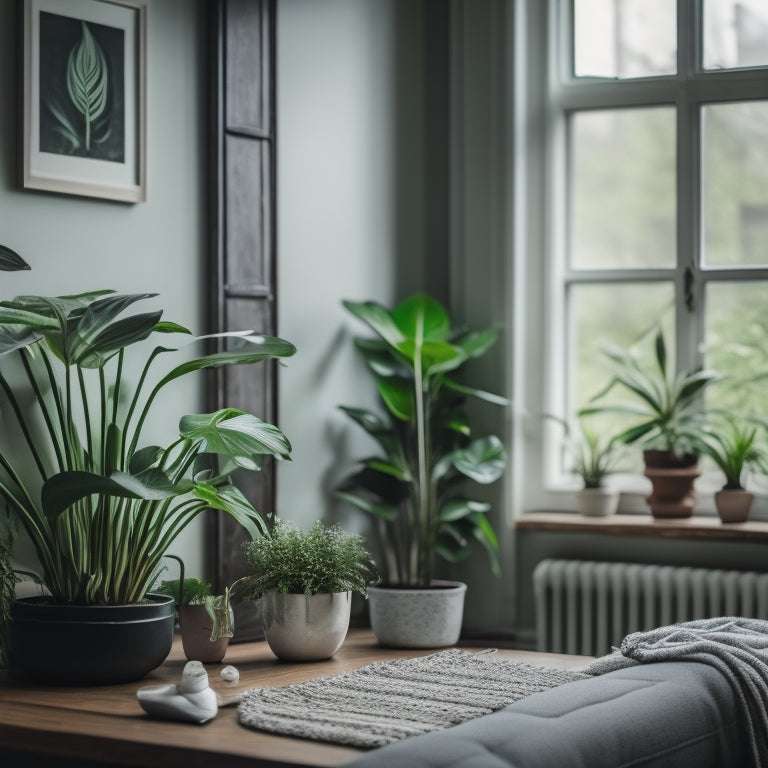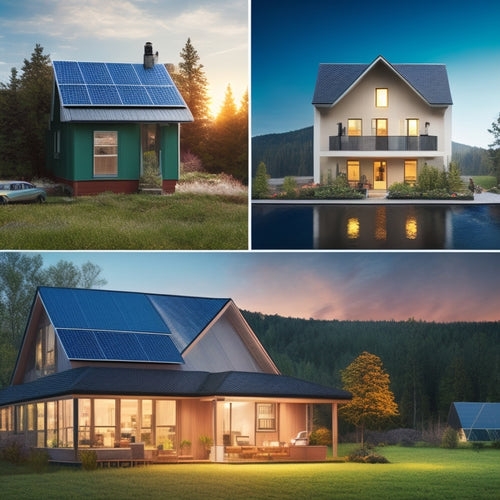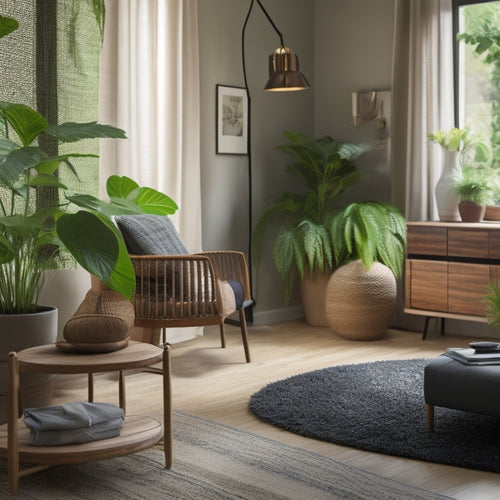
What Natural Air Purifiers Work Best for Apartments?
Share
You can effectively combat indoor air pollution in your apartment using natural air purifiers. Peace lilies, spider plants, and snake plants are scientifically proven to remove pollutants and toxins, making them a great start. Activated carbon air purifiers are also a viable option, capturing chemicals, gases, and odors with high adsorption capacity. While salt lamps have some limited benefits, they're not the most effective solution. DIY methods, such as homemade sprays and charcoal filters, can also provide a cost-effective and eco-friendly alternative. As you investigate further, you'll uncover the most effective natural air purifiers for your apartment.
Key Takeaways
- Peace lilies and spider plants are effective natural air purifiers for apartments, removing pollutants like ammonia and formaldehyde.
- Activated charcoal filters or sprays can be used to absorb impurities and odors, providing a cost-effective DIY solution.
- Indoor plants like snake plants are low-maintenance and combat trichloroethylene and formaldehyde, making them a great apartment option.
- Natural air purifiers can be used in conjunction with each other to create a multi-layered approach to air purification in apartments.
- DIY air purification methods are often environmentally friendly and can be a more affordable alternative to commercial products for apartment dwellers.
Top Natural Air Purifiers for Apartments
You often find yourself wondering which natural air purifiers are most effective for your apartment. When it comes to improving indoor air quality, you have several options.
The best apartment plants, for instance, are a cost-effective and low-maintenance solution. Many eco-conscious buyers are also turning to electric cars, which reduce emissions and offer government incentives, making them a smart choice for those wanting to minimize their environmental impact.
These plants have been scientifically proven to remove pollutants and toxins from the air, improving overall indoor air quality. Some of the most effective plants for air purification include peace lilies, spider plants, and aloe vera.
Plants That Clean Indoor Air
Inside your apartment, pollutants and toxins can accumulate, compromising indoor air quality. Indoor gardening can be a natural solution to purify the air. Some plants are more effective than others in removing pollutants and toxins. Here's a selection of plants that can help:
| Plant | Removes | Benefits |
|---|---|---|
| Spider Plant | Formaldehyde, Xylene | Easy to care for, great air purifier |
| Peace Lily | Ammonia, Benzene | Beautiful white blooms, reduces stress |
| Snake Plant | Trichloroethylene, Formaldehyde | Low maintenance, improves air quality |
Activated Carbon Air Purifiers
Certain air purification methods can be more effective than others in removing pollutants and toxins from apartment air. Activated carbon air purifiers are a popular choice for apartments due to their ability to capture chemicals, gases, and odors.
With the increasing adoption of electric vehicles, many apartment dwellers are also considering the benefits of home charging installation to reduce their carbon footprint. The benefits of activated carbon include its high adsorption capacity, making it effective against volatile organic compounds (VOCs) and other pollutants.
Additionally, much like how electric vehicles can save up to $14,500 on fuel costs over 15 years, using an activated carbon air purifier can lead to long-term savings on healthcare costs by removing pollutants from the air.
When using an activated carbon air purifier, it's crucial to maintain the carbon filter regularly to guarantee peak performance. This involves replacing the filter every 3-6 months, depending on usage and manufacturer's instructions.
Salt Lamps for Air Purification
Many apartment dwellers are drawn to salt lamps as a natural air purification method, thanks to their aesthetic appeal and purported health benefits. You might be wondering if they really work.
The benefits of salt lamps are often exaggerated, and it's crucial to distinguish fact from fiction. While salt lamps can help remove some pollutants from the air, their effectiveness is limited. They work by attracting moisture, which can trap some pollutants, but they're not effective against gases, odors, or smaller particles.
In contrast, fast charging infrastructure can facilitate a quicker shift to eco-friendly practices. Similarly, sustainable EV charging systems prioritize energy efficiency.
Be cautious of salt lamp myths claiming they can cure allergies or asthma. In reality, they're more of a decorative piece with some minor air purification benefits. If you're looking for a natural air purifier, it's vital to explore more effective options.
DIY Air Purification Methods
Several DIY air purification methods can be effective alternatives to commercial products. You can create homemade sprays using essential oils like tea tree oil, lavender oil, and lemon oil, which have natural antibacterial and antiviral properties.
For instance, incorporating renewable energy sources in your apartment's ventilation system can also contribute to cleaner air. Additionally, considering eco-friendly charging solutions for electric vehicles can have a positive impact on the environment, which in turn affects indoor air quality.
Mix a few drops of these oils with water and spray them around your apartment to eliminate airborne pathogens. Another method is to use activated charcoal, a natural air purifier that absorbs impurities and odors. You can place activated charcoal filters in your air vents or use charcoal-based air purifying bags.
Additionally, you can grow indoor plants like peace lilies or spider plants, which are known to purify the air naturally. These DIY methods can be cost-effective and environmentally friendly alternatives to commercial air purifiers.
Frequently Asked Questions
Can I Use Natural Air Purifiers in Apartments With Pets?
You can effectively use natural air purifiers in apartments with pets, opting for pet-friendly options that won't harm your furry friends, while improving air quality by removing pollutants and allergens, promoting a healthier living space.
How Often Should I Replace Natural Air Purifiers in My Apartment?
You're wondering how often to replace natural air purifiers in your apartment, but first, let's explore the vital factor: air quality. Depending on usage and pollution levels, you'll need to replace them every 6-12 months to maintain ideal air quality and effectiveness.
Do Natural Air Purifiers Work for Apartments With Mold Issues?
You'll find that natural air purifiers can be effective for apartments with mold issues if you choose ones that focus on mold prevention by controlling indoor humidity, which helps prevent spore growth and reduces mold's spread.
Can I Use Natural Air Purifiers in Apartments With Open Floor Plans?
Like a skilled designer designing a grand cathedral, you're crafting a harmonious space in your open floor plan apartment. To optimize air quality, you'll want to strategically place natural air purifiers, considering airflow and pollutant sources to breathe easy and live free.
Are Natural Air Purifiers Effective for Apartments Near High-Traffic Areas?
You're wondering if natural air purifiers can combat poor air quality near high-traffic areas. Fortunately, indoor plants like peace lilies and spider plants can effectively remove pollutants, improving air quality and creating a healthier environment for you to thrive in.
Related Posts
-

What Does Your Home Energy Audit Report Reveal?
Your home energy audit report reveals a detailed analysis of your energy consumption patterns, highlighting areas of ...
-

10 Eco-Friendly Air Management Tools for Clean Home Living
You're taking an essential step towards creating a healthier living space by seeking eco-friendly air management tool...
-

10 Best Sustainable Waste Management Solutions for Green Homes
You're likely unaware that the average green home generates over 2 kilograms of waste daily, but with the right susta...


